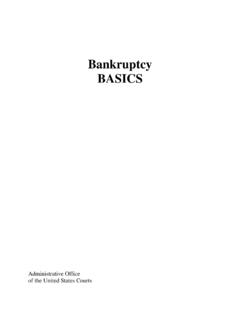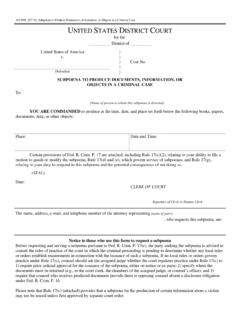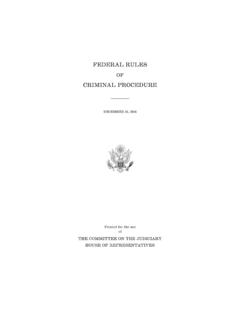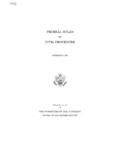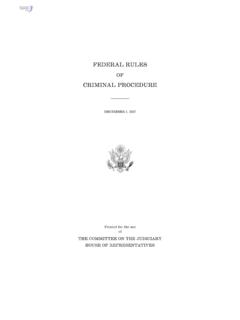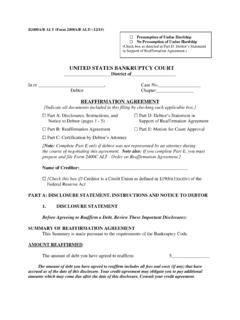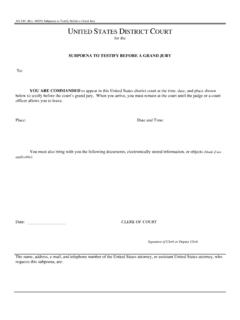Transcription of Handbook for Federal Grand Jurors
1 Handbook for Federal Grand Jurors Prepared for the use of Grand Jurors serving in the United States district courts under the supervision of the Judicial Conference of the United States. Published by the Administrative Office of the United States Courts, Washington, 20544. CONTENTS. PURPOSE OF THIS 1. ORIGIN AND HISTORY OF THE Grand 1. NATURE OF THE Grand 3. (1) The Grand Jury's 4. (2) 5. SELECTION OF Grand 6. ORGANIZATION, OATH, AND OFFICERS. OF THE Federal Grand 6. 7. (1) 7. (2) Evidence Before the Grand 8. (3) Questioning the 8. (4) Calling the Person Being Investigated by the Government as a Witness.
2 10. (5) The Evidence Needed Before a True Bill May Be 11. (6) Deliberations .. 11. 13. PROTECTION OF Grand 14. PRACTICAL SUGGESTIONS FOR Grand . Jurors .. 14. GLOSSARY OF 16. PURPOSE OF THIS Handbook . This Handbook will acquaint persons who have been selected to serve on a Federal Grand jury with the general nature and importance of their role as Grand Jurors . It explains some of the terms that Grand Jurors will encounter during their service and offers some suggestions helpful to them in performing this important public service. It is intended that this Handbook will, to a degree, repeat and provide a permanent record of much of the information presented in the Grand jury orientation film, The People's Panel, which in most districts is shown to Grand Jurors at the commencement of their service.
3 Grand Jurors are encouraged to refer to this Handbook periodically throughout their service to reacquaint themselves with their duties and responsibilities. This Handbook is designed as an aid only to persons serving on a Federal not a state Grand jury. The Federal Grand jury is concerned only with Federal crimes; it derives its authority from the Constitution of the United States, national laws, and the rules of the Federal courts. There are also Grand juries impaneled in many of the states, but those Grand juries investigate only state crimes;. they derive their authority from the constitutions, laws, and rules of court of the states where they are impaneled.
4 ORIGIN AND HISTORY OF THE Grand JURY. The Grand jury has a long and honorable tradition. It was recognized in the Magna Carta, the first English constitutional document, which King John granted in 1215 at the demand of his subjects. The first English Grand jury consisted of 12 men selected from the knights or other freemen, who were summoned to inquire into 1. crimes alleged to have been committed in their local community. Thus, Grand Jurors originally functioned as accusers or witnesses, rather than as judges. Over the years, the hallmarks of our modern Grand jury developed in England.
5 For example, Grand jury proceedings became secret, and the Grand jury became independent of the Crown. As a result, a Grand jury is able to vote an indictment or refuse to do so, as it deems proper, without regard to the recommendations of judge, prosecutor, or any other person. This independence from the will of the government was achieved only after a long hard fight. It can best be illustrated by the celebrated English case involving the Earl of Shaftasbury, who, in 1681, fell under the suspicion of the Crown. Displeased with him, the Crown presented to the Grand jury a proposed bill of indictment for high treason and recommended that it be voted and returned.
6 After hearing the witnesses, the Grand jury voted against the bill of indictment and returned it to the King, holding that it was not true. When the English colonists came to America, they brought with them many of the institutions of the English legal system, including the Grand jury. Thus, the English tradition of the Grand jury was well established in the American colonies long before the American Revolution. Indeed, the colonists used it as a platform from which to assert their independence from the pressures of colonial governors. In 1735, for example, the Colonial Governor of New York demanded that a Grand jury indict for libel John Zenger, editor of a newspaper called The Weekly Journal, because he had held up to scorn certain acts of the Royal Governor.
7 The Grand jury flatly refused. 2. The Grand jury as an institution was so firmly established in the traditions of our forebears that they included it in the Bill of Rights. The Fifth Amendment to the Constitution of the United States provides in part that (n)o person shall be held to answer for a capital, or otherwise infamous crime, unless on a presentment or indictment of a Grand Jury .. Moreover, the Grand jury system is also recognized in the constitutions of many of the states of the Union. NATURE OF THE Grand JURY. The powers and functions of the Federal Grand jury differ from those of the Federal trial jury, which is called the petit jury.
8 The petit jury listens to the evidence offered by the prosecution and the defense (if it chooses to offer any) during a criminal trial and returns a verdict of guilty or not guilty. The Grand jury, on the other hand, does not determine guilt or innocence, but only whether there is probable cause to believe that a crime was committed and that a specific person or persons committed it. If the Grand jury finds that probable cause exists against a person suspected of having committed the crime, then it will return a written statement of the charges called an indictment.
9 After that, the person will go to trial. The Grand jury normally hears only that evidence presented by a government attorney, which tends to show the commission of a crime. The government attorney usually is the United States Attorney or an Assistant United States Attorney in the Federal district. The Grand jury must determine from this evidence, and usually without hearing evidence for the defense, whether the person being investigated by the government should be tried for a serious Federal crime, referred to in the Bill of Rights as an infamous crime. An 3. infamous crime is one which may be punished by imprisonment for more than one year.
10 As a general rule, no one can be prosecuted for a serious crime unless the Grand jury decides that the evidence it has heard so requires. In this way, the Grand jury operates both as a sword, authorizing the government's prosecution of suspected criminals, and also as a shield, protecting citizens from unwarranted or inappropriate prosecutions. The person being investigated by the government may, however, waive Grand jury proceedings and agree to be prosecuted by a written charge of crime called an information. The Grand jury is not completely free to compel a trial of anyone it chooses.
